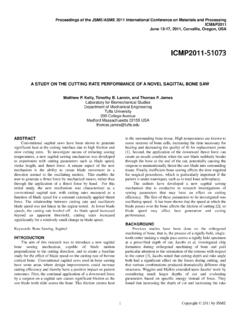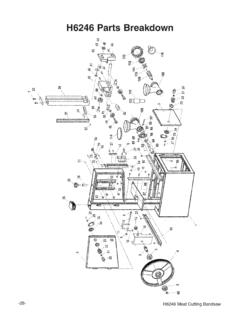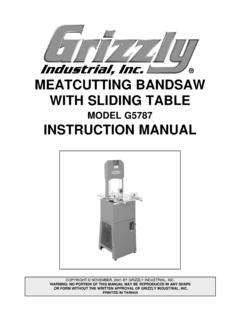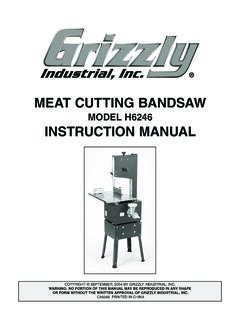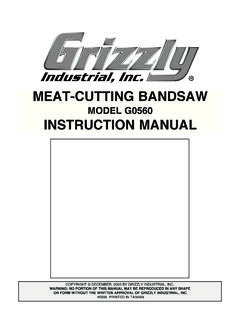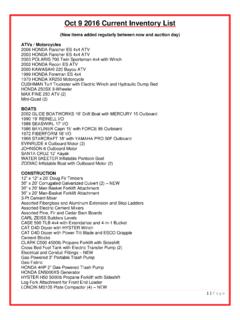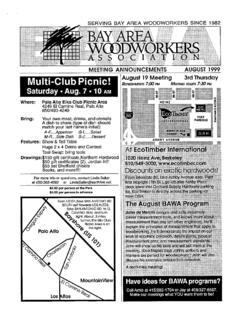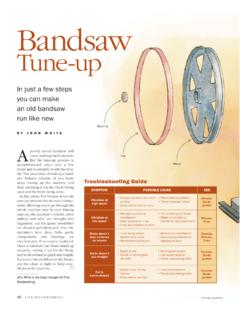Transcription of RECIPROCATING BONE SAW: EFFECT OF BLADE SPEED ON …
1 1 Copyright 2011 by ASME Proceedings of the ASME 2011 International Mechanical Engineering Congress & Exposition IMECE2011 November 11-17, 2011, Denver, Colorado, USA IMECE2011-62457 RECIPROCATING bone SAW: EFFECT OF BLADE SPEED ON CUTTING RATE Timothy B. Lannin, Matthew P. Kelly, and Thomas P. James Laboratory for Biomechanical Studies Department of Mechanical Engineering Tufts University 200 College Avenue Medford, Massachusetts 02155 USA ABSTRACT Power RECIPROCATING saws are used in surgical procedures to cut bone . Improved cutting rates are desirable in order to reduce operative time and improve patient outcome.
2 A fixture was developed to test the EFFECT of BLADE SPEED on cutting rate of bovine cortical bone . It was hypothesized that the volumetric cutting rate would increase in a linear manner for a fixed stroke length and a constant thrust force. A N thrust force was applied. The RECIPROCATING stroke length was held constant at mm. Using an 18 TPI BLADE , cutting rate was determined to increase in a slightly non-linear manner, with disproportionately higher cutting rate at higher BLADE speeds. The data implies that a higher RECIPROCATING frequency may invoke more efficient cutting.
3 Keywords: bone Sawing, RECIPROCATING INTRODUCTION Powered RECIPROCATING saws are used to shape and transect bone . While hand saws perform well, powered saws are desirable due to their higher cutting rates and compact size. Higher cutting rates reduce the time required for surgical procedures. This is especially important in cases where a patient extremity is under tourniquet. In addition, frictional heating between the BLADE and the bony bed can occur, resulting in elevated temperature at the bone surface. High temperatures are known to cause thermal necrosis of bone cells [1].
4 The death of bone cells due to high temperature can prolong patient healing time and decrease the efficacy of implant fit. In bone sawing processes, higher cutting rates can be achieved by increasing BLADE SPEED [2]. For RECIPROCATING saws, BLADE SPEED is dependent on two parameters: stroke length and RECIPROCATING rate. It is preferable to increase BLADE SPEED through an increase in RECIPROCATING rate, rather than by changing stroke length. In confined areas, a RECIPROCATING saw with a longer stroke length increases the likelihood of damaging adjacent tissue.
5 Outside of orthopedic medicine, RECIPROCATING saws for construction and demolition employ orbital action, which is an alteration to the straight-line RECIPROCATING path of conventional saws. For orbital action, the path of the BLADE is an ellipse in which the major axis coincides with primary stroke direction and the minor axis is normal to the surface of the workpiece. The small amplitude chopping of orbital action is present in construction/demolition RECIPROCATING saws to improve cutting rates in wood and metal. As of this writing, no data has been published on the effectiveness of orbital action in sawing bone .
6 A novel bone saw with orbital action has been developed for this study. The aim of this research was to investigate the EFFECT of BLADE SPEED on cutting rate of a RECIPROCATING saw with constant orbital action and constant stroke length. BACKGROUND RECIPROCATING saws are used to cut bone in a variety of surgical procedures. The saws generally come in two sizes and related configurations. For oral and maxillofacial surgery, RECIPROCATING saws and related blades are quite small, often referred to by surgeons as micro RECIPROCATING saws or simply as small bone saws.
7 These saws are being used, for example, by oral surgeons for alveolar ridge reduction and removal of mandibular tori, rather than the more time-consuming approach of using burs [3,4]. In orthognathic surgery, RECIPROCATING saws are commonly used to perform maxillary osteotomies. Micro RECIPROCATING saws are also used in the retrieval of bone grafts, such as in calvarial and iliac crest bone harvests [5]. The configuration of a micro RECIPROCATING saw is cylindrical as shown in Figure 1. 2 Copyright 2011 by ASME Figure 1 TYPICAL CONFIGURATION OF A MICRO RECIPROCATING SAW.
8 The second type of RECIPROCATING saw is commonly referred to as a large bone saw. This configuration resembles the pistol grip configuration of a sagittal saw. Large bone RECIPROCATING saws and a representative BLADE are shown in Figure 2. A typical application of this saw is in unicompartmental knee arthroplasty or in a median sternotomy [6]. The sternal version of the saw has an attachment to guard the tip of the RECIPROCATING BLADE , so as to avoid piercing tissue and organs. (A) (B) Figure 2 (A) LARGE bone RECIPROCATING SAWS AND (B) REPRESENTATIVE BLADE AS USED IN EXPERIMENT.
9 RECIPROCATING frequencies of large bone saws are approximately 13,000 cycles per minute (217 Hz) and stroke lengths are generally around mm. When comparing micro RECIPROCATING saws to large bone saws, the RECIPROCATING frequency of the micro saws tends to be greater, but the stroke length is less. Average BLADE SPEED is proportional to both the RECIPROCATING frequency and stroke length, so by this measure both types of saws have comparable BLADE speeds. Building on the knowledge base from metal machining theory, bone sawing has been studied extensively as an orthogonal cutting process [7, 8].
10 During orthogonal cutting, a single cutting edge, which is wider than the workpiece, is positioned so that the cutting edge is perpendicular to the direction of cutting. For orthogonal studies, however, BLADE SPEED has been limited by the SPEED at which the bed of a mill or a shaper can traverse, which is an order of magnitude less than BLADE speeds of a typical surgical RECIPROCATING saw. In order to study the EFFECT of higher BLADE speeds on cutting rate, a new RECIPROCATING sawing fixture was developed. EXPERIMENTAL FIXTURE RECIPROCATING BLADE motion is created with a modified slider-crank mechanism.
